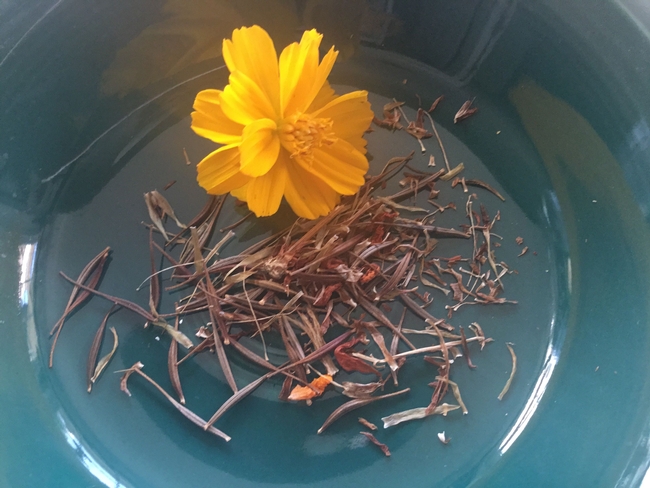UC Gardening Blogs
Why Are LGFs Eating My Sunflowers?
I have a bird and bee-friendly yard—native and nonnative annuals, perennials, birdbath, and both birdseed and Nyjer feeders, hummingbird feeders also. There are lots of bees, hummers, scrub jays, wrens, and occasional black phoebe. But the most common and largest number of birds are lesser goldfinches. ( I call them LGFs for short!)
The feeders are clean and continuously filled, yet I see the little monsters (LGFs) pecking away at the broad green sunflower leaves! Why? So I did some research.
Apparently, this is very common in California. They are not eating insects on the leaves, but actually swallowing chunks of the greenery! The sunflower seeds don't seem to interest them.
Some bird experts believe that the minerals and vitamins are necessary for the birds during breeding and growth periods. Little research has been done on this as apparently, the LGFs do not affect the large commercial sunflower fields.
Other garden sources for the “salad eaters” are Jerusalem artichokes and lettuce that has gone to seed as well as seeds and tender buds of native plants.
I have also seen the little guys nibbling the cosmos seeds in my flower beds.
So—what to do? Other gardeners suggest netting, sparkling streamers, or spinning pie plates. I have decided to just plant more sunflowers, spacing them throughout the garden and yard in the hope that some will be overlooked and not skeletonized!
Next year, for sure!
UC Davis Students Carry on Legacy of Walnut Twig Beetle Expert Steve Seybold
The legacy of chemical ecologist Steven Seybold thrives with the recent publication...
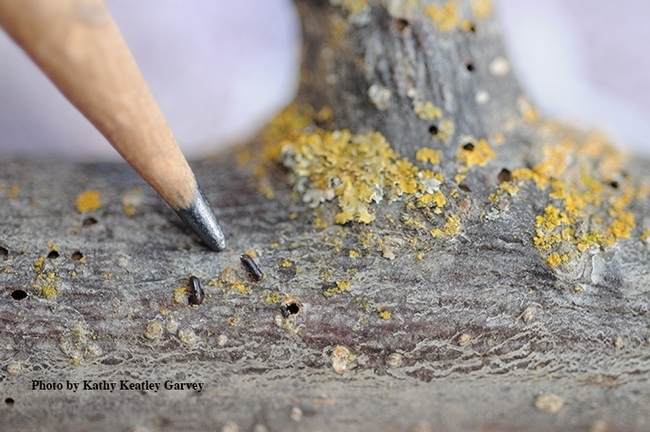
The walnut twig beetle, Pityophthorus juglandis, in association with a fungus, causes the thousand cankers disease. (Photo by Kathy Keatley Garvey)
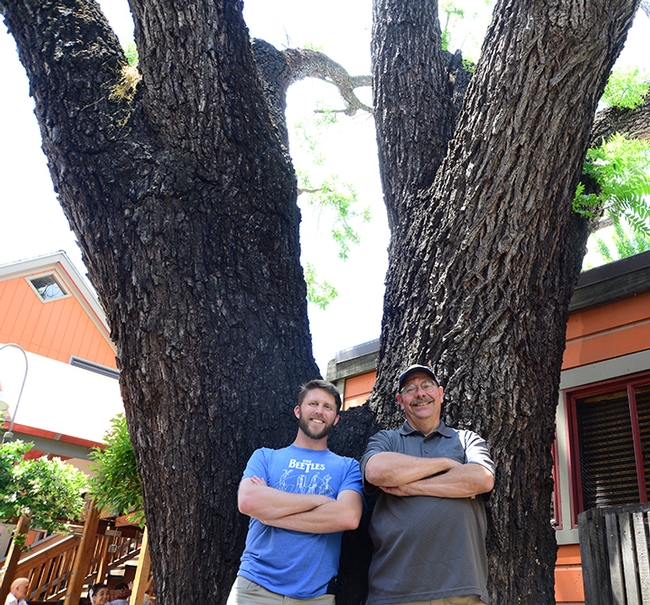
Forest entomologist Jackson Audley (left) with his mentor, the late Steve Seybold, in front of an infested tree in Davis, Calif. The walnut twig beetle, in association with a fungus, causes thousand cankers disease. (Photo by Kathy Keatley Garvey)
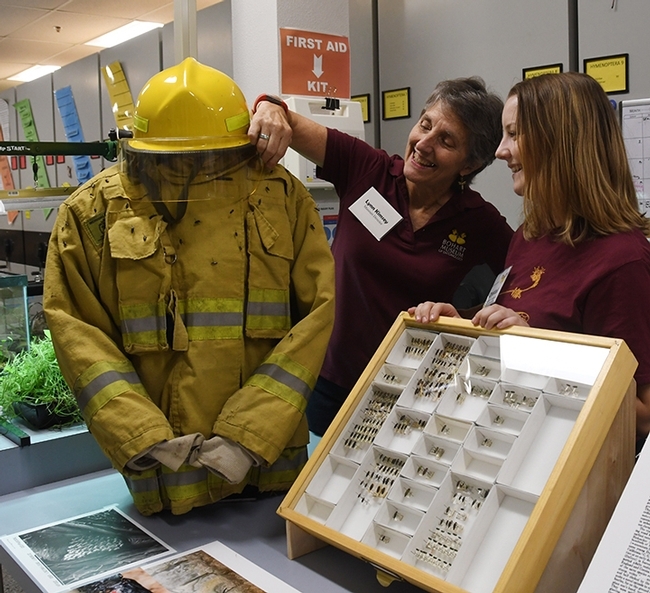
UC Davis doctoral student Crystal Homicz (right) participating in a forest entomology open house at the Bohart Museum of Entomology. With her is Professor Lynn Kimsey, director of the Bohart. (Photo by Kathy Keatley Garvey)
UC Davis Research: A Double Punch to the Blue Orchard Bee
In a first-of-its-kind study, UC Davis research shows that the double punch of pesticide exposure...
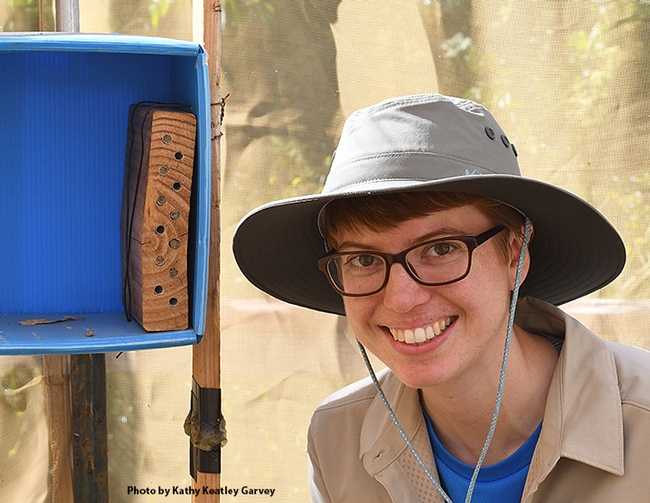
UC Davis doctoral student Clara Stuligross by her blue orchard bee nests in the spring of 2018. (Photo by Kathy Keatley Garvey)
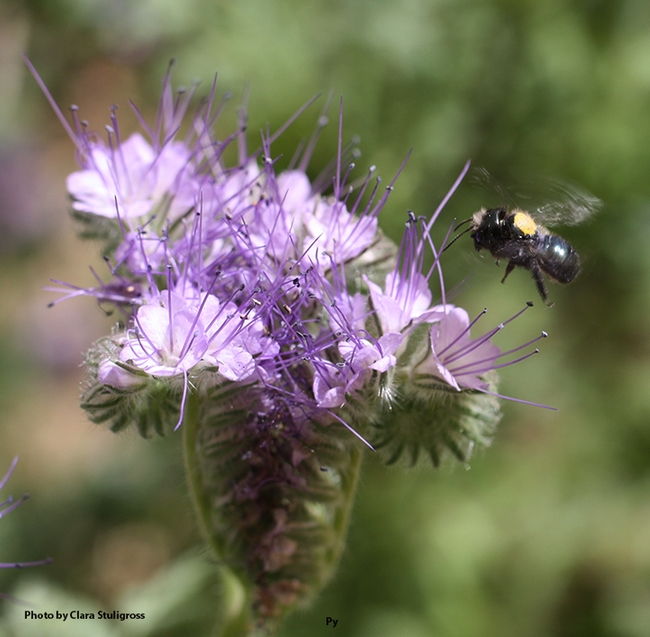
A blue orchard bee, Osmia lignaria (marked in yellow), heading for Phacelia tanacetifolia. (Photo by Clara Stuligross)
The Pool is Gone - Project complete
by Mel Kendall We have been working on redoing our yard since March of this year. ...
Lessons from a First-Time Heirloom Tomato Home Gardener
I've never grown heirloom tomatoes before but have always been fascinated by the different varieties, colors and sizes of these beauties. I see them at our local Farmers Market during the summer season but never buy any because they're expensive. I always get the regular cherry or Roma variety.I did not know why heirloom tomatoes were so highly prized untilI enrolled in the 2018 Master Gardeners Program when I formally got introduced to them.I found that heirloom tomatoes are prized by home gardeners and have been grown from generation to generation. They are open pollinated, i.e, “the flower is pollinated with pollen from another plant to make a fruit with seeds that can reproduce the tomato, true to type. Growers can save seed from their crop and sow again in following years and the plants will produce fruit with the same characteristics and quality of the parent. The seeds can be passed down so they become heirlooms.”There is a time for everything under the sun - including planting my first heirloom tomatoes on April 24, 2020 - 38 days after the COVID-19 pandemic lockdown was announced.Let me tell you how it happened.Last April 13 and a few weeks after the Mar 18 lockdown, an email from our MG Coordinator Jennifer B. (bless her heart), forwarded an email announcing the availability of approx 800 heirloom tomato plant varieties for give-away. The 2020 Annual Spring Heirloom Tomato Plant Sale of the Yolo County Master Gardener Program was cancelled due to the COVID lockdown. A donation per plant was encouraged and a specific date was set with strict pick-up protocols. I put in my request and like an excited little girl, I had my hubby drive me to Woodland to pick up my first heirloom tomato plants on April 15.I chose 10 heirloom tomato plants including one 4-pack tomato mystery plants; gave four away to another Master Gardener and two plants to my son-in-law. I ended up with eight (8) leggy plants two of which were determinate (det.) where “ the plant grows to a certain point then stops and sets fruit which mostly ripens in a short period of time. The height is often four feet or less and may not need staking.” I was even more excited to get six (6) indeterminate (ind.) heirlooms including the mystery pack where “the plant grows continually until it dies at the end of the season, continuing to flower, set, and ripen fruit. Plants can get quite large and most often produce best when staked or grown in a wire cage.” I was hoping I could get more fruits from the “indeterminates” through the end of summer and if I'm lucky some might over-winter.I planted all the following varieties in containers except one:Amanda Orange - Ind.Big Rainbow - IndPink Berkeley Tie Dye - Ind.Legend - DetLime Green Salad - DetMystery Pack:Pork Chop - Ind.Mortgage Lifter - Ind.Spears Tennessee Green - Ind.Lessons I learned:1). Soil is foundational to growing healthy plants. Instead of getting an organic potting mix from big stores, I opted to order an organic “more better” soil mix from a local manufacturer. Am so glad I got a cubic yard and the soil did not disappoint.2.) “Hardening off” tomato plants previously grown in a controlled greenhouse environment is a MUST. I followed the instructions that came with the plants by keeping them indoors for the first five (5) days. On the 6th day I started putting them on the east side of the house for morning sun and took them inside after a few hours. I did this up to the 10th day slowly increasing the plants' outside exposure to “harden” them from the elements they have to contend with when planted outside. On the 11th day, they stayed in full sunlight until planting time.3). Use the right size container forheirloom tomatoes. I planted two indeterminate varieties, Big Rainbow and Amana Orange in twobig plastic containers, one in a raised planter bed and the rest in 5-gallon black plastic containers. MISTAKE! I should have planted ALL the indeterminates in big containers or in my raised planter beds.4). Plant leggy tomato plantshorizontally in the soil with only a few top leaves showing. Do not plant them straight up. There are root hairs on their leggy stems which when buried horizontally and comes in contact with the soil will grow a new plant. It was fascinating to see new shoots coming out of the ground after a month or so. That's why large container pots are the way to go.5). I used an all purpose organic fertilizer (4-4-4) to feed the plants once during their growing season. I also gave them calcium watering from pulverized dried egg shells twice during their flowering time. On hind side, I should have fed them fertilizer every month during their growing and flowering season.6). Heirloom tomatoes are prettyspecial and should be treated as such. I watered the plants daily in their early stages of growth; then every other day. On really hot days I watered them daily because the soil in containers tend to dry up quickly. I made sure though to stick my fingers in the soil before I watered. I pinched the suckers growing in-between the main stem and the branches and pruned the branches/leaves closest to the soil. I staked the plants or put a wire cage around them. I found that staking was better for easier handling of the branches. I pruned the plants a number of times to facilitate better air circulation and sunlight. Every time I pruned or watered the plants, I would talk to them. Crazy, right? I didn't care. They were my babies.7). I pruned even more leaves from the bottom of the plants when they started bearing fruits and had to retie the fruit-bearing branches several times. I noticed some fruits had blossom end-rot while a few fruits were cracked. I found out that the reason for these conditions was extreme fluctuations in soil moisture. Side dressing with compost might have solved the problem but it was too late. I'll know better next time around.8). My favorite varieties are Big Rainbow, Amana Orange, and Lime Green Salad. My very first fruits came from Lime Green Salad with small round-shaped fruits, chartreuse in color; juicy and tangy. Amana Orange fruits are huge and light orange beefsteak tomatoes. Deliciously sweet. Big Rainbow beefsteaks are even sweeter. When sliced, the fruit has streaks of yellow and red colors. Both Amana Orange and Big Rainbow are prolific growers. A slow grower, Lime Green Salad is a good fruit producer. Legend, Lime Green Salad and Pink Berkeley Tie Die fruits ripen early season. The rest ripens mid season except Amana Orange whose fruits ripen late.9). Tomato fruits do not tolerate temperatures over 95 degrees. They become mushy and lose some of their vibrant colors. Do not wait too long to harvest ripening tomatoes especially during hot, hot summer days. I learned my lesson.I was excited to share the tomatoes with my daughter and her family when they came to visit on Labor Day weekend. The temperature that Saturday, Sept 5, was over 90 degrees. I should have picked most of the ripened fruits before they came but wanted to show them off so I decided to wait until Sunday. To my dismay, Sept 6 was even hotter. When I decided to pick up the tomatoes that Sunday morning, they were soooo soft they were almost ready to burst.On September 7, my husband and I flew to New Haven, Connecticutto help supervise our 7 and 4 year old grandkids with their on-line schooling. We won't be back in CA until Oct 31. I am thankful I was able to bring a shoebox of tomatoes (heat survivors!) for my son and fam to enjoy.I left my ‘babies' and I don't know how they are doing now especially after the fires which I learned dumped a lot of ashes on my garden plants. Sigh.But I can always look forward to planting them again next year. Sure glad I was able to save seeds from most of the earlier harvests. For a first-time heirloom tomato grower, I think I did alright (tap on the back!!).References:HeirloomTomatoesReference Sheet2020 Tomato Heirloom VarietiesAnnual Spring Plant Sale -UCCEMaster Gardeners of Yolo CountyUCANR Publications




